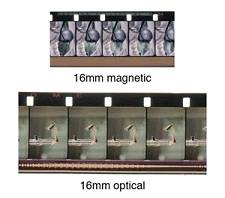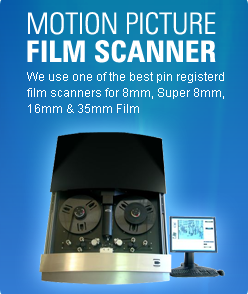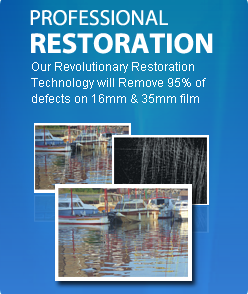
Regular 8mm movie film was never sold commercially with a sound strip but some people did attach a sound strip themselves. Super 8 film has the option but you had to buy the film with the sound strip on it and you had to have a sound camera and microphone. 16mm had both magnetic and optical. On the order form you can let us know if you think your film has sound on it. It does take extra effort to capture the sound and incorporate it into the requested formats. So, we do charge a little more for sound film.
We can not capture any digital audio like Dolby Digital or Sony Dynamic Digital Sound.


The above picture is just an example. 16mm sound film came in many different varieties. 16mm film with optical sound will have sprocket holes on 1 side. The other side will carry the audio track.
There is no sound on Regular 8 film. At least it wasn't produced that way. There were some people that put a magnetic sound strip on 8mm film themselves. There was also some test 8mm film with sound that Kodak used to prepare for Super 8 film.
Even though Super 8 film was sold in two versions, sound and silent, most Super 8 film is silent. Only about 5% of all Super 8 movie film has sound on it.
Super 8 sound could be recorded with a microphone during filming or could also be recorded using a projector when the film played. The quality of the sound varied widely.
Rockford Fun Facts: The city is home to Rockford College, as well as Judson College, Rock Valley College, and a satellite campus of Northern Illinois University. Nicknamed the Forest City, Rockford has been long known for its abundance of elm trees. Founded in 1834 by Germanicus Kent, Rockford was originally known as the village of Midway due to its location midway between Chicago and Kent's hometown of Galena. In 1837 the community's name was officially changed to Rock Ford and in 1852 Rockford was incorporated as a city.
Illinois Fun Facts: In the second half of the 19th century the great need for workers in the mills, rail yards and slaughterhouses made Chicago a popular destination for immigrants and freed blacks. During Prohibition Chicago became synonymous with bootleg liquor and gangsters like Al Capone. The first Europeans to visit Illinois were the French explorers Louis Jolliet and Jacques Marquette in 1673, but the region was ceded to Britain after the French and Indian War. After the American Revolution, Illinois became a territory of the United States, and achieved statehood in 1818.





